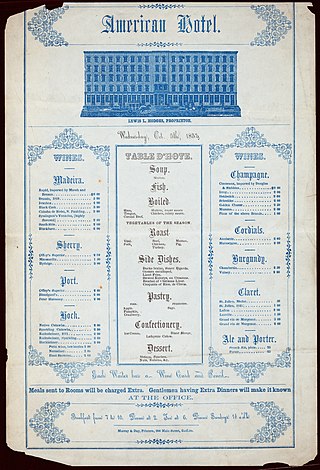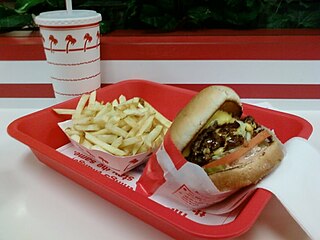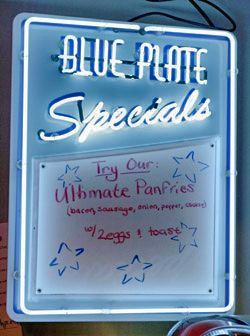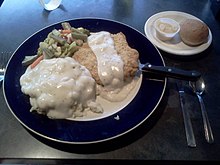
Alfred Damon Runyon was an American journalist and short-story writer.

A greasy spoon is a small, cheap restaurant typically specializing in fried foods. The term greasy spoon has been used in the United States since at least the 1920s to describe diners and coffee shops, and is presently used throughout the United Kingdom and the Republic of Ireland to refer to British and Irish cafes. According to the Oxford English Dictionary, the term greasy spoon originated in the United States and is now used in various English-speaking countries.
Dinner usually refers to what is in many Western cultures the biggest and most formal meal of the day. Historically, the largest meal used to be eaten around midday, and called dinner. Especially among the elite, it gradually migrated to later in the day over the 16th to 19th centuries. The word has different meanings depending on culture, and may mean a meal of any size eaten at any time of day. In particular, it is still sometimes used for a meal at noon or in the early afternoon on special occasions, such as a Christmas dinner. In hot climates, the main meal is more likely to be eaten in the evening, after the temperature has fallen.

The Immigrant is a 1917 American silent romantic comedy short. The film stars Charlie Chaplin's Tramp character as an immigrant coming to the United States who is accused of theft on the voyage across the Atlantic Ocean and falls in love with a beautiful young woman along the way. It also stars Edna Purviance and Eric Campbell.

A Dagwood sandwich is a tall, multilayered sandwich made with a variety of meats, cheeses, and condiments. It is named after Dagwood Bumstead, a central character in the comic strip Blondie, who is frequently illustrated making enormous sandwiches. According to Blondie scripter Dean Young, his father, Chic Young, began drawing the huge sandwiches in the comic strip in 1936.

Cha chaan teng, often called a Hong Kong-style cafe or diner in English, is a type of restaurant that originated in Hong Kong. Cha chaan teng are commonly found in Hong Kong, Macau, and parts of Guangdong. Due to the waves of mass migrations from Hong Kong in the 1980s, they are now established in major Chinese communities in Western countries such as Australia, Canada, the United Kingdom, and the United States. Likened to a greasy spoon cafe or an American diner, cha chaan tengs are known for eclectic and affordable menus, which include dishes from Hong Kong cuisine and Hong Kong-style Western cuisine. They draw comparisons to Western cafés due to their casual settings, as well as menus revolving around coffee and tea.

A buffet can be either a sideboard or a system of serving meals in which food is placed in a public area where the diners serve themselves. A form of service à la française, buffets are offered at various places including hotels, restaurants, and many social events. Buffet restaurants normally offer all-you-can-eat food for a set price, but some measure prices by weight or by number of dishes. Buffets usually have some or mostly hot dishes, so the term cold buffet has been developed to describe formats lacking hot food. Hot or cold buffets usually involve dishware and utensils, but a finger buffet is an array of foods that are designed to be small and easily consumed only by hand, such as cupcakes, slices of pizza, foods on cocktail sticks, etc.

Tableware items are the dishware and utensils used for setting a table, serving food, and dining. The term includes cutlery, glassware, serving dishes, serving utensils, and other items used for practical as well as decorative purposes. The quality, nature, variety and number of objects varies according to culture, religion, number of diners, cuisine and occasion. For example, Middle Eastern, Indian or Polynesian food culture and cuisine sometimes limits tableware to serving dishes, using bread or leaves as individual plates, and not infrequently without use of cutlery. Special occasions are usually reflected in higher quality tableware.

In restaurant terminology, a table d'hôte menu is a menu where multi-course meals with only a few choices are charged at a fixed total price. Such a menu may be called prix fixe. The terms set meal and set menu are also used.

A side dish, sometimes referred to as a side order, side item, or simply a side, is a food item that accompanies the entrée or main course at a meal.

A meat and three meal is one where the customer picks one meat and three side dishes as a fixed-price offering. Meats commonly include fried chicken, country ham, beef, country-fried steak, meatloaf, or pork chop; and sides span from vegetables such as potatoes, corn, and green beans, to macaroni and cheese, hush puppies, and spaghetti. A dessert, such as gelatin, is often offered. Typical accompaniments include cornbread and sweet tea.
Silver service is a method of food service at the table, with the waiter transferring food from a serving dish to the guest's plate, always from the left. It is performed by a waiter using service forks and spoons from the diner's left. In France, it appears to be now known as service à l'anglaise, although historically that meant something else, with the hostess serving out the soup at one end of the table, and later the host carving a joint of meat at the other end, and diners serving themselves with other dishes present.

Diner lingo is a kind of American verbal slang used by cooks and chefs in diners and diner-style restaurants, and by the wait staff to communicate their orders to the cooks. Usage of terms with similar meaning, propagated by oral culture within each establishment, may vary by region or even among restaurants in the same locale.
Restaurants fall into several industry classifications, based upon menu style, preparation methods and pricing, as well as the means by which the food is served to the customer. This article mainly describes the situation in the US, while categorisation differs widely around the world.
Jane Grossman Stern and Michael Stern are American writers who specialize in books about travel, food, and popular culture. They are best known for their Roadfood books, website, and magazine columns, in which they find road food restaurants serving classic American regional specialties and review them. Starting their hunt for regional American food in the early 1970s they were the first food writers to regard this food as being as worthy to report on as the haute cuisine of other nations.

Customs and etiquette in Chinese dining are the traditional behaviors observed while eating in Greater China. Traditional Han customs have spread throughout East Asia to varying degrees, with some regions sharing a few aspects of formal dining, which has ranged from guest seating to paying the bill.
Blue Plate Special may refer to:

A combination meal, often referred as a combo-meal, is a type of meal that typically includes food items and a beverage. They are a common menu item at fast food restaurants, and other restaurants also purvey them. Combination meals may be priced lower compared to ordering items separately, but this is not always the case. A combination meal is also a meal in which the consumer orders items à la carte to create their own meal combination.

Fuller's Coffee Shop is a diner serving standard American cuisine in Portland, Oregon's Pearl District, in the United States. Established in 1947, the restaurant has operated from its location in downtown Portland since 1960. It serves breakfast all day, and the menu features a cheeseburger with a recipe that has not changed since the diner's establishment. Described as a greasy spoon, Fuller's has received a generally positive reception, and appeared in an episode of the television series Grimm in 2017. Founded by Jack Fuller, the diner was later owned by his son John then by Urban Restaurant Group.
















